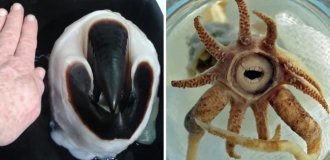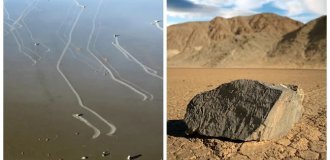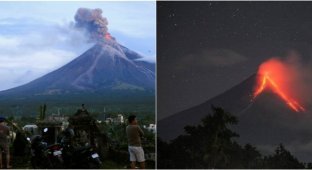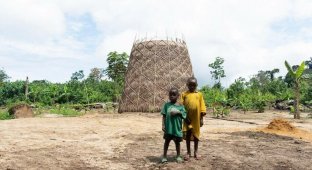Brighter than the rainbow. Multi-colored lakes of Kelimutu volcano (7 photos)
It’s difficult to surprise a sophisticated tourist with colorful reservoirs. It seems that there is no range in the palette that would not be reflected in the water surface of the lakes. Pink, carmine red, thick gray, boiling white, all shades of blue and green, black, purple and even yellow - there is no limit to the variety of colors. 
Lakes of Kelimutu volcano in modern times/ © travelask.ru
But from the long list of striking attractions, the lakes of the Kelimutu volcano, located on the island of Flores in Indonesia, stand out especially. These are colored blots located in three calderas of one volcano. Two of them are separated by a thin stone lintel, and the third is located a little further away. Not only are bodies of water different in color from each other, but they can also change it - sometimes slightly, and sometimes very radically. For example, from sky blue to deep black. And this is not a trick of the light, as sometimes happens with the surface of the sea. This is the result of chemical processes constantly occurring in the rock mass.
Three nozzles of one volcano
The Kelimutu volcano is not particularly tall - only 1639 meters. It is a full member of the Pacific volcanic ring of fire, and therefore can still be active, “spitting” a stream of ash and gases into the air. The last time this happened was in 1968, and it was then, as they write in various sources, that three calderas appeared, filling with water over time.
But that's not true. The three unusual colors of the lake were known to the aborigines back in the century before last. The first European visited them in 1915, and the colored reservoirs were described in 1929. Then what seemed unusual to scientists was not the color palette, but the presence of three calderas in close proximity to each other. Typically, an eruption occurs through one vent, leaving behind one caldera. And here there are three “nozzles”, each with one common chamber underneath. This is rare among volcanoes. 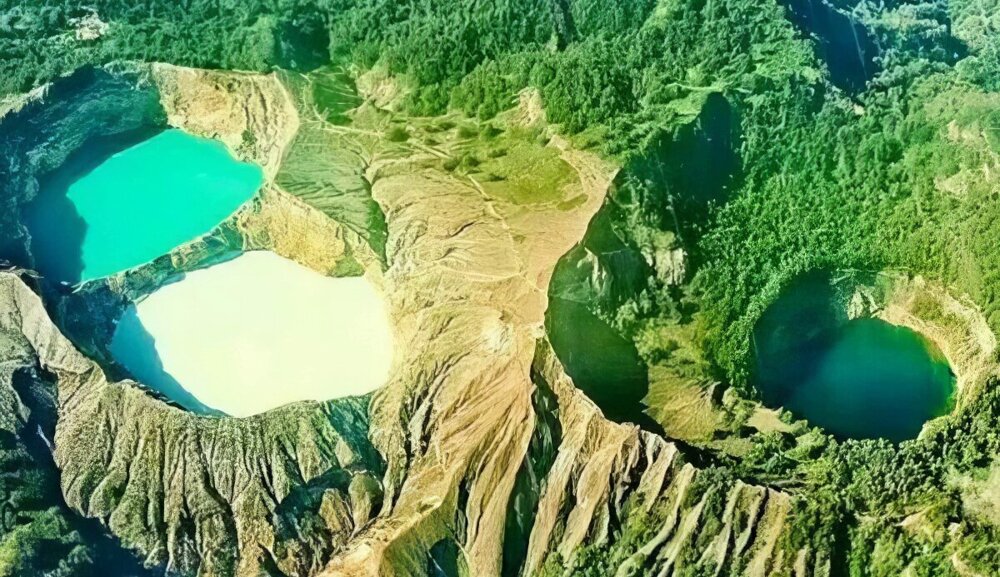
Lakes of Kelimutu volcano in the early 2000s/ © volcano.si.edu
After Kelimutu fell silent, rainwater quickly filled the calderas. This is how three lakes arose - an attraction for tourists and a source of myths and legends for the local population. These are completely drainless reservoirs, which are filled exclusively by rain. Flores Island is located in the tropical zone and the wet season here lasts for six months. Therefore, Lake Kelimutu does not experience a shortage of water. Something else is interesting about them. Namely, a change in color.
Chemistry, climate and no mysticism
Since scientists began monitoring the reservoirs, they have changed their color 12 times. Lake Sorcerers, which was once soft blue (more on the names below), eventually became brownish-red. And Lake of the Old Men first brightened, acquiring unnatural yellow-green shades, and then became ebony-black. Only Lake Molodykh, located in the middle, remains true to the original palette and sometimes turns from turquoise to cheerful greens. 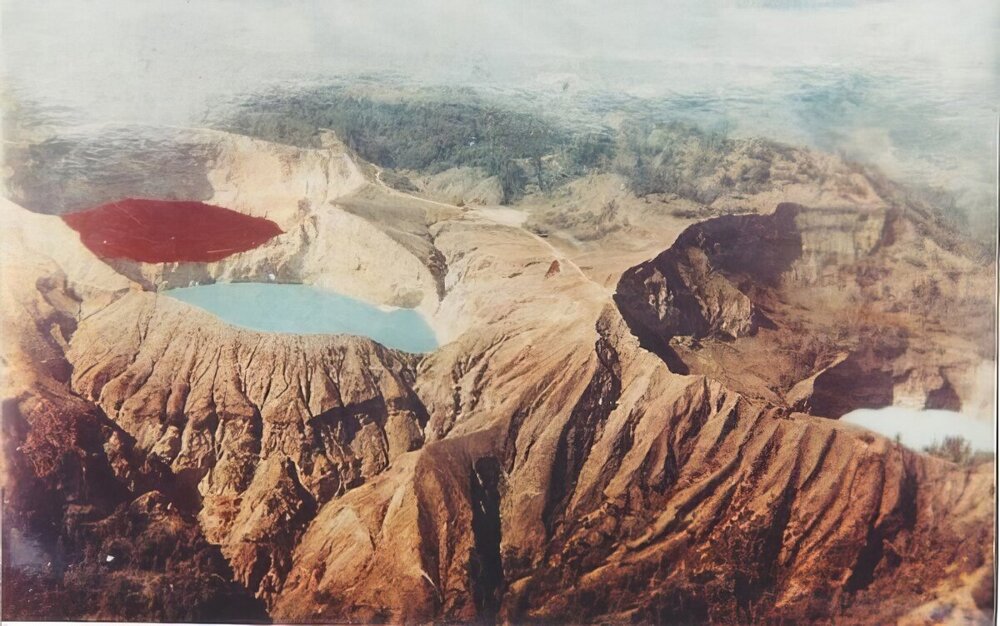
This is what the lakes on the Kelimutu volcano looked like in the last century/ © volcano.si.edu
Moreover, no one can predict what color the water will be in a year or two - the change of palette occurs at least gradually, but without any system. Scientists have an explanation for this. The fact is that the rocks that make up the walls of calderas have a loose structure. Over time, water erodes them, reaches a layer of some mineral and turns into its colors. In addition, the chemical composition of water itself works better than other solvents, because it is a mixture of hydrochloric and sulfuric acids. By the way, green-blue color is precisely the product of such a mixture.
And when the acid reaches iron, manganese or sulfur, it reacts with them and turns red, yellow, or even black. And that is not all. Add to this the climate: since the lakes are recharged only by rainwater, by the end of the dry season it becomes significantly less, and therefore the concentration of chemistry changes. This entails another color change. 
The reason for the rich color of the water lies in the chemical plane/ © volcano.si.edu
And the third factor is underwater fumaroles, from which volcanic gas periodically enters the lake. It not only lifts heavier layers of water from the bottom, changing the color scheme, but also saturates the lake with hydrogen sulfide. This sometimes makes the surface of two bodies of water look like quietly boiling water.and the stove has jellied meat - lazy bubbles rise from the bottom and spread out in a circle around the surface. They also cause the smell and toxic fog that sometimes envelops the lakes.
Photography at the cost of life
However, tourists (and there are quite a lot of them here) are not in any danger from this. The three lakes of the Kelimutu volcano are located in basins with practically reciprocal walls and the distance from their edges to the water surface is about 5 meters. The risk here is different - for the sake of spectacular shots, desperate travelers sometimes embark on reckless adventures, trying to get as close to the water as possible. Well, they pay for it with their lives. So, in 2015, a Dutch tourist fell into Lake Sorcerers. They tried to search for his body, but did it without much diligence, since the Ph level of the reservoir is 0.5 units, and this approximately corresponds to the acidity of the electrolyte in the battery. In addition, the caldera goes down an impressive 800 meters, so any rescue operations here are pointless. 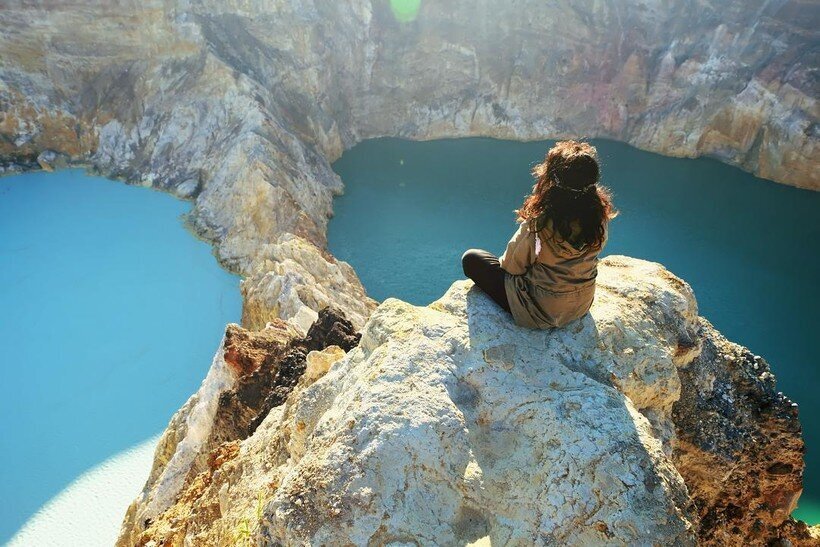
This girl clearly neglected the safety rules/ © azertag.az
In order to prevent accidents, the authorities of Kelimutu National Park have installed iron fences and equipped platforms from which all three lakes can be safely viewed. And still there are those who climb over the railings and pose against the backdrop of black, red and green water.
Refuge of Souls
Local residents view them with disapproval. For them, the colored lakes at the top of the volcano are sacred reservoirs, each of which has its own purpose. Standing a little on the outskirts is called Lake of the Old Men. The souls of elderly people move there after death. They lived a long life and gained the wisdom that comes only with age. Therefore, its waters are painted in a deep dark color. If Lake of Old Men changes its palette, it is within the dark shades. Sometimes it turns deep red, sometimes dark green. And in 2013, as monitoring records show, Starikov Lake suddenly turned carefree blue for six months, which greatly frightened the local population. 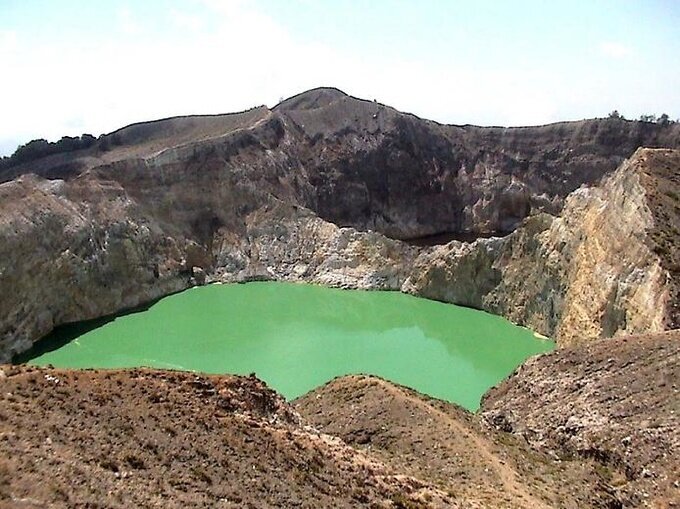
Starikov Lake suddenly became brighter in 2017, causing alarm and panic among local residents/ © volcano.si.edu
The body of water located in the middle is named Lake of Young Souls. This is a haven for the spirits of children who left the world prematurely. Its water is usually light, and over the history of observations it has acquired a greenish, turquoise, or pink hue. This is where color changes most often, while remaining in the calm part of the spectrum.
But Lake of the Sorcerers is the most unpredictable of all three. According to local legends, it serves as the last refuge for villains and sinners. Its color is mainly blood red, brown or dark blue. But during the peak rainy season, it can turn deep gray or mossy green. It was into this body of water that a Dutch tourist fell while chasing a beautiful photo. And, by the way, after this the lake, as if warning the living, once again changed color, turning from dark blue to frightening purple.
The local population interprets any change in color as a harbinger of some kind of trouble. Therefore, the longer bodies of water remain calm, the better. But scientists are forced to disappoint them - the day is not far off when the thin stone bulkhead connecting the Lake of the Young with the Lake of the Sorcerers will simply disappear. Either as a result of an earthquake, or it will finally be “eaten” by chemically active water. And then, according to the imagination of the people living here, the souls of sorcerers and villains will mix with young pure beings and the end of the world will come. 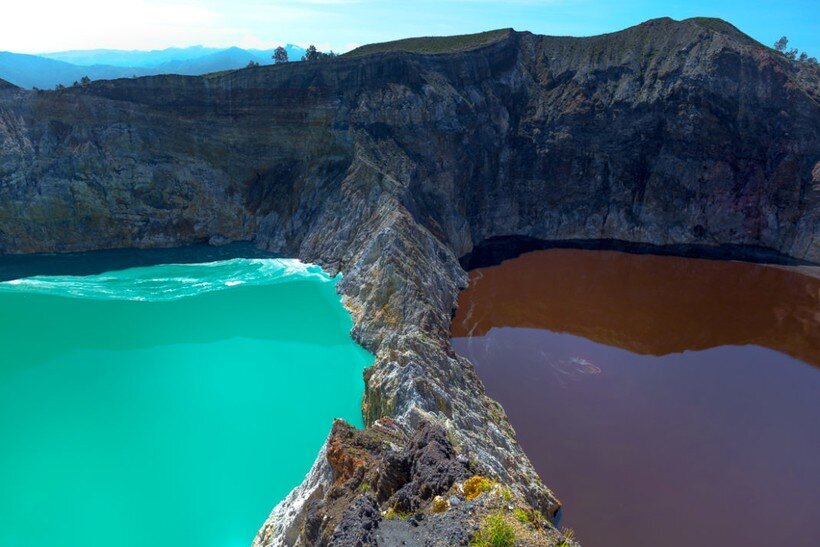
The bridge between the lakes is gradually becoming thinner/ © travelask.ru
But it is still far away, and the lakes of the Kelimutu volcano continue to attract tourists who want to see the rainbow palette of unusual bodies of water, admire the poisonous fog and listen to local legends.



